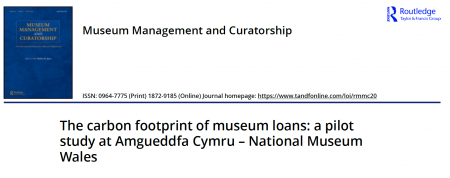The carbon footprint of museum loans: a pilot study at Amgueddfa Cymru - National Museum Wales

“Global awareness of climate change is on the rise and a growing number of sectors are being engaged including museums. The museum sector in the United Kingdom (UK) has begun to expect improvements in the environmental friendliness of the exhibitions industry (Mellor 2008; National Museum Directors’ Conference 2009), and its professionals are asking for tools to measure sustainability (Museums Association 2009, 8). In the years to come, this demand is likely to extend worldwide as museums recognize their responsibility to limit the collateral effects of their activities on the environment.
The ‘carbon footprint’ is a simple metric that shows how an activity contributes to climate change. It takes into account carbon dioxide (CO2) and other greenhouse gases (GHGs) such as methane and nitrous oxide. A museum’s complete carbon footprint should reveal how all its operations affect climate change. It is reasonably easy for museums to measure on-site activities, such as gas and electricity use, by using online tools or specialized auditing agencies. However, this represents only part of their impact. Little information exists to help museums measure off-site, complex operations such as loans.
The aim of this article is to suggest a new carbon footprinting methodology designed specifically for museum loan activities. It also includes a performance indicator for the environmental impact of loans (EIL) to encourage museums to balance their environmental responsibility with the growing demand for increased access and collections mobility. To design the methodology, initial data were collected at the Art Department of Amgueddfa Cymru – National Museum Wales” (p.210-211).
